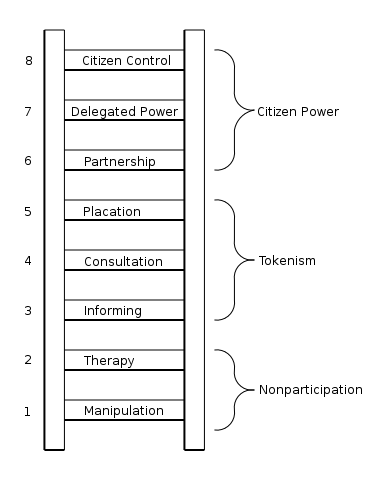Where Organisations Go Wrong

A lot happened in 1969. The moon landing, Led Zeppelin was released (the first LZ album), the maiden flight of the Boeing 747, and a paper by Sherry Arnstein.
It’s difficult to say which is the most important of those above, but Arnstein’s paper is probably the least famous.
Context
I frequently speak with directors and project leaders who introduce their voice of the customer initiative as the way that they interact with customers. That’s the way the company understands what customers are saying, what customers want, etc. After some digging since it’s never completely easy to find the one team (often because they operate under a different name, but someone thought Voice of the Customer would be a good title for what they do), I find that the initiative is a survey with some analysis of the results. That’s usually about the scope of the delivery: a survey.
I then usually respond with introducing them to Sherry Arnstein’s paper on The Ladder of Citizen Participation. While the paper focussed on the interaction between public sector organisations and their citizens, it’s equally applicable to private sector companies.
Content
Arstein concisely describes a vertical hierarchy of how public services interact with the citizens and how the organisation harnesses the input of those citizens. The least involved are at the bottom rungs of the ladder and the most involved are at the top. There are 8 rungs, ranging from Manipulation at the bottom up to Citizen Control at the top.
While the rung descriptions are useful, the power of the article is in the further categorisation of all 8 rungs into 3 levels. I find that the terms used in these levels created a quicker response in my clients than the description themselves. The terms highlight the true interaction: Non-participation, Tokenism, Citizen Power. The implication that the first two levels of Non-participation and Tokenism don’t really involve the citizens’ agenda, just using their views to push the organisation’s agenda. So naturally, every client, when faced with the ladder, wants to be higher than they already are. They all fear the top rungs, as giving away power to the customers/service users, but want to pitch somewhere in between where they are now and just under the top one or two rungs.
Examples
I normally start at the second rung with an example of how local authorities are adapting to reduced budgets. “We’re going to reduce your bin collection from weekly to fortnightly”. On it’s own that’s just a statement of intent. It fits into therapy when we add “and here are some tips about how you can recycle more so you don’t fill up your black bin too early”. There are better phrases than that (and a lot worse), but the point is that the organisation is helping its customers adapt to the change. Note that the customers haven’t actually had any say in whether it should be weekly or fortnightly.
Consultation is the favourite of many of a public organisation, e.g “we’re thinking of making a change. Here’s are the two options that we’ve already chosen for you to pick from. We’ll hear concerns but the decision is ours.” That’s effectively what the organisation is saying in a consultation. The final decision rests with the organisation. Often the choices are just that, choices of predetermined options, with no potential to create a solution that could work for all parties if it’s not already listed as an option.
Even though consultation is a favourite of public organisations, it’s still tokenism. It’s interesting to see the shift in clients who are perfectly happy with the concept of consultations – since that’s what their organisation has always done – when confronted with the fact that it’s tokenisation. The shift moves them up the ladder to better inclusion of customers.
More forward-thinking councils have customers on strategic boards, acting as an equal member compared to the staff. That’s either Placation or Partnership depending on the level of involvement, the decisions that those boards can make (some with customers on are restricted in their decision scope) and the balance of customers to staff. Once we’re at the Partnership rung, then we’re moving into Citizen Power.
Applying to Your Organisation
Now consider your organisation’s voice of the customer service. How far does it allow a thorough two-way dialogue? Are you only allowing comments of certain types to be heard? What route do you have for those comments to affect your organisation’s strategy?
When you’re next designing a new service or product, or redesigning existing products, do you have customers in the room with you? Do you have customers on the decision-making boards/panels? And what happens if they are not present? Can the board still continue on that day or does it have to postpone since there are customer roles accounted for specifically in the quorum?
References
https://lithgow-schmidt.dk/sherry-arnstein/ladder-of-citizen-participation.html
A spanish translation:
https://rua.ua.es/dspace/bitstream/10045/16699/2/ESCALERA_ARNSTEIN_1969.pdf


Recent Comments